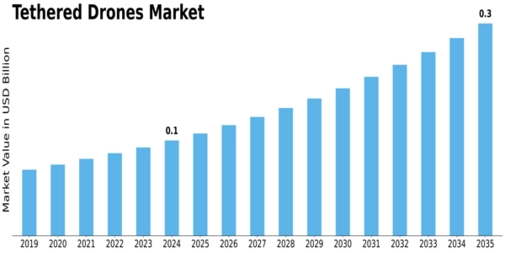Tether Technology Trends: From Lightweight Cables to AI-Driven Tethered Drone Systems

The tethered drones market is emerging as a mission-critical component of military modernization initiatives worldwide, especially as defense forces seek persistent surveillance, uninterrupted aerial monitoring, and rapid deployment of intelligence-gathering platforms. As part of the fast-evolving drones market, tethered UAVs are becoming increasingly essential for battlefield situational awareness, border control, convoy protection, communication support, and tactical overwatch. (MRFR) reports that the global tethered drones market, valued at USD 0.15 billion in 2024, will grow to USD 0.29 billion by 2035, supported by a 6.10% CAGR driven significantly by military and security use cases.
Traditional unmanned aerial vehicles offer excellent flexibility, but their flight time is limited by battery constraints. By contrast, tethered drone market systems deliver constant power from a ground station, allowing them to stay airborne for hours. This endurance makes them particularly valuable for defense missions requiring long-duration observation, real-time video intelligence, and 360-degree aerial coverage. Tethered drones operate as elevated surveillance towers and are often deployed to monitor borders, military bases, checkpoints, high-value assets, and active combat zones.
Modern military forces increasingly integrate tethered drone technology into their intelligence, surveillance, and reconnaissance (ISR) strategies. These systems equip forces with sensors, EO/IR cameras, thermal imaging, and secure communication links, enabling high-quality situational awareness even in low-visibility or high-risk environments. Since tethered drones remain connected to a ground power and data source, they offer enhanced cybersecurity, reduced interference risks, and stable data transmission—key features that defense organizations prioritize.
Tethered drones are also used extensively in border patrol operations. Their elevated vantage point and continuous flight capabilities enable comprehensive monitoring of border regions, helping detect illegal activities, unauthorized crossings, and potential threats. Defense agencies can rapidly deploy tethered drones during crisis situations, enabling real-time assessment without risking personnel safety. This makes them essential tools for modern defense infrastructures and homeland security efforts.
Another important application within the defense environment is the support of communication networks. Tethered drones can serve as temporary communication nodes, relays, or signal boosters during military operations or emergency deployments. Their ability to rapidly create airborne communication bridges is particularly valuable in remote areas where conventional infrastructure is unavailable or damaged.
As geopolitical tensions rise globally, the demand for surveillance and counter-surveillance technologies continues to grow, influencing the parallel expansion of both the tethered drones market and the anti tethered drones market. Defense forces not only rely on tethered UAVs for monitoring but must also protect their airspace from hostile drones. While tethered drones do not typically pose the same risk as autonomous drones, their presence requires integrated counter-UAV strategies to ensure operational security.
Regionally, North America dominates defense adoption due to its advanced military capabilities, extensive border security programs, and continued investment in unmanned systems. Europe follows closely with defense modernization projects, while Asia-Pacific countries, particularly China and India, are expanding tethered drone deployments for both military surveillance and critical infrastructure protection.
Despite strong demand, tethered drone systems face challenges in defense deployment, including weather limitations, mobility restrictions, and the need for rugged tether cables capable of withstanding harsh conditions. However, ongoing technological advancements—such as stronger tether materials, improved encryption, and better payload capabilities—are helping overcome these barriers.
Looking ahead, the role of tethered drones in defense is expected to expand significantly. With increasing global focus on real-time intelligence and border surveillance, tethered drone technology will remain a critical asset for defense organizations worldwide. As the market grows steadily toward its 2035 forecast, tethered drones are set to strengthen their position as one of the most reliable and strategic tools in modern military operations.
- vTethered_Drones_Market
- Tethered_Drones_Market_Size
- Tethered_Drones_Market_Share
- Tethered_Drones_Market_Trends
- Tethered_Drones_Market_Growth
- Tethered_Drones_Market_Analysis
- Tethered_Drones_Market_Forecast
- Global_Tethered_Drones_Market
- Tethered_Drones_Market_Report
- Global_Tethered_Drones_Market_Report

- Biografi
- Sanat
- Bilim
- Firma
- Teknoloji
- Eğitim
- Film
- Spor
- Yemek
- Oyun
- Botanik
- Sağlık
- Ev
- Finans
- Kariyer
- Tanıtım
- Diğer
- Eğlence
- Otomotiv
- E-Ticaret
- Spor
- Yazılım
- Haber
- Hobi
